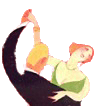 |
ROUND DANCING — CHOREOGRAPHED BALLROOMEDUCATIONAL ARTICLESMAJOR SECTIONS: Figures | Articles | Links | Alph. Index | Search | Home |
|
|
TURNING WALKING INTO DANCING -- DANCING ON THE DIAGONALby Harold & Meredith Sears As round dancers, we are well trained to think about the four cardinal directions: line of dance, reverse, wall, and center. The cue might be "face the wall and box," and we do it. If we do two forward waltzes and then a left turning box, we will carefully face center, reverse, wall, and then line again. But you can look a good bit more stylish if you focus more on the other four directions: diagonal line and wall, diagonal line and center, diagonal reverse and center, and diagonal reverse and wall. Where the left turning box (phase II in waltz) turns us through the four "cardinal" directions, a diamond turn (phase IV) turns us through the diagonal points of the compass. At the end of the first measure, we should be facing not center but diagonal reverse and center. We should finish this figure facing line and center. An open telemark is designed to move us from diagonal line and center to diagonal line and wall. Dancing on the diagonals produces a soft, flowing pattern: a little into the center, then back toward the wall; a wave-like motion, something more like natural flow and less like plane geometry in school. Soldiers march in straight lines, smooth circles of a defined radius, and in strictly oriented box-like patterns. Graceful dancing should mimic something more out of Mother Nature: an undulating stream-bed, a path wandering through the forest, waves running up the beach, reaching higher here and lower there.And good choreographers will select their figures to do just this: take us a little into the center, then back toward the wall, into the center again, and so on. Late in 2004, Brent & Judy Moore released a phase IV waltz called, Blue Wings. The introduction ends with a roll 3 down line and then a chasse to semi, facing line and wall. Then we do one left turn; a hover corte; and a back whisk to line and wall; thru semi chasse and in and out runs to line and center;;; a weave to line and wall;; maneuver and spin turn to line and wall;; back and chasse to banjo facing reverse and center; check and develope and then open impetus to line and center;; weave to semi line and wall;; chair and slip to line and center; and so on. About the same time, Jim & Bonnie Bahr released their Broken Hearts. Part B starts with a really interesting telespin to reverse and center;; check & weave 5 and slow switch to line and wall;; natural weave to line and wall;; three step and half natural and weave ending to line and wall;;; change of direction to line and center; and of course there is much more. The orientation of many
intermediate and advanced figures is on the diagonal, and our dancers'
focus should be there, too. Don't "fix" it. Don't shift yourself around
so you're lined up "properly." Dancing on the diagonals is both proper
and graceful.
A version of this article appeared as “Icing On the Cake” in the Dixie Round Dance Council (DRDC) Newsletter, March, 2005, and excerpt reprinted in Dallas Harvest Holiday, 47:4, p 2, 4/2007.
If you would like to read other articles on dance position, technique, styling, and specific dance rhythms, you may visit the article TOC. Past DRDC Educational Articles archived here. Go beyond this site. Find other references on our Sources and Links pages.
|
 |
|
|
Page last revised